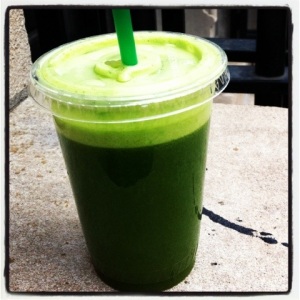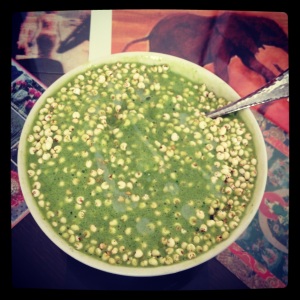I got a request last week to do a post on whether juice or smoothies are better for you. Though the yearly lists of predicted food trends for 2014 aren’t out quite yet, it doesn’t seem that juicing is going out of style any time soon.
 In 2012, I wrote an article for Food & Nutrition Magazine about the juicing trend. I got to delve into The Literature and interview some experts in the field, noting their varying opinions. While there’s plenty of clinical research on fruit and vegetable intake and even intake of juice powders, there’s still virtually nothing on juice cleanses.
In 2012, I wrote an article for Food & Nutrition Magazine about the juicing trend. I got to delve into The Literature and interview some experts in the field, noting their varying opinions. While there’s plenty of clinical research on fruit and vegetable intake and even intake of juice powders, there’s still virtually nothing on juice cleanses.
In general, I’m not a fan of cleanses. However, if someone wants to hit the reset button by subsisting on liquids for a day or two a couple times a year because it motivates them to get back on track, I’m not going to take that away from them. Unless that liquid is, like, beer. Or whiskey. Also not a great idea.
I think juice can have a place in our everyday diet, as long as we account for it within our daily calorie intake. It can be a great way to give your body a potent dose of essential vitamins and minerals. Sometimes when we’re sick and liquids are more appealing than solid foods, juice can be a good way to get some nutrients. For day-to-day consumption, though, you can keep sugar (and calorie) intake in check, stick to mostly vegetables, adding say, some apple to your green juice instead of spiking your apple-orange-pineappe juice with a handful of kale. Also note that juice does not retain the fiber from the whole fruits and vegetables, so if your brain doesn’t really register liquids as having consumed something, keep that in mind so you don’t find yourself reaching for a snack twenty minutes later.
Like juice, smoothies can pack a lot of nutrition into one glass. With the help of a blender, it’s easy to combine fruits, vegetables, and other things into something that can actually pass as a meal. Since you drink everything you put into the machine, you retain the fiber in the produce and don’t end up with a bunch of leftover pulp. This also means you can get away with using less produce if budget is a concern. Smoothies also quite versatile in that you can make them as light or as filling as you want by adding things like yogurt, protein powders, nuts, seeds, and other add-ins.
I knew a guy who worked as bartender and used to bring a blender full of his “dinner” so he could sip his meal while he worked. That certainly wouldn’t work for a lot of people, but based on his recipe, he was getting enough calories, protein, and other nutrients to keep him going throughout his shift.
So if you’re trying to decide whether juice or a smoothie is the better option, think of what you want from it. If you’re looking for a quick dose of liquid nutrition to cover some of your fruit/vegetable needs for the day, you might want to try juice. However, if you’re looking for something that will actually fill you up, consider a smoothie. In either case, don’t be afraid to experiment with different combinations!
Do you prefer juice or smoothies? Any favorite recipes?
